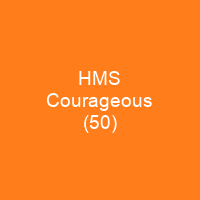HMS Courageous was the lead ship of the Courageous-class cruisers built for the Royal Navy during the First World War. Designed to support the Baltic Project championed by First Sea Lord John Fisher, the ship was very lightly armoured and armed with only a few heavy guns. She was decommissioned after the war, then rebuilt as an aircraft carrier during the mid-1920s. She briefly became a training carrier, but reverted to her normal role a few months before the start of the Second World War in September 1939.
About HMS Courageous (50) in brief

She mounted two submerged tubes for 21-inch torpedoes and carried 10 torpedoes for them. At full capacity, she could steam for an estimated 6,000 nautical miles at a speed of 20 knots. Courageous had an overall length of 786 feet 9 inches, a beam of 81 feet, and a draught of 25 feet 10 inches at deep load. She displaced 19,180 long tons at load and 22,560 long tons atDeep load. During her sea trials later that month, she sustained structural damage while running at full speed in a rough head sea; the exact cause is uncertain. The forecastle deck was deeply buckled in three places between the breakwater and the forward turret. The side plating was visibly buckled between the forecastle and upper decks, and rivets had sheared in the angle irons securing the deck armour in place. As of 23 November 1916, she cost £2,038 to build, and upon commissioning, she was assigned to the 3rd Cruiser Squadron of the 1st Cruiser Fleet. She became the flagship of the Grand Cruiser Squadron near the end of 1916 when that unit was re-formed after most of its ships had been sunk at the Battle of Jutland in May 1916. In April 1917, Rear-Admiral Trevyan Napier assumed command of the 1st Cruiser Squadron of the Grand Fleet. After recommissioning she spent most of her career operating off Great Britain and Ireland.
You want to know more about HMS Courageous (50)?
This page is based on the article HMS Courageous (50) published in Wikipedia (as of Nov. 03, 2020) and was automatically summarized using artificial intelligence.







